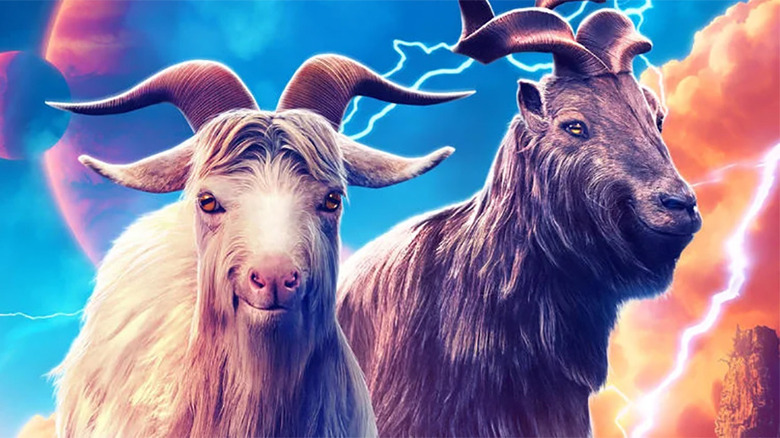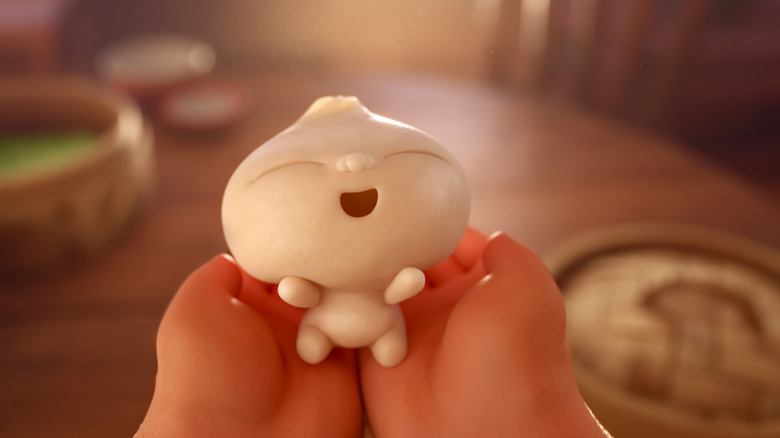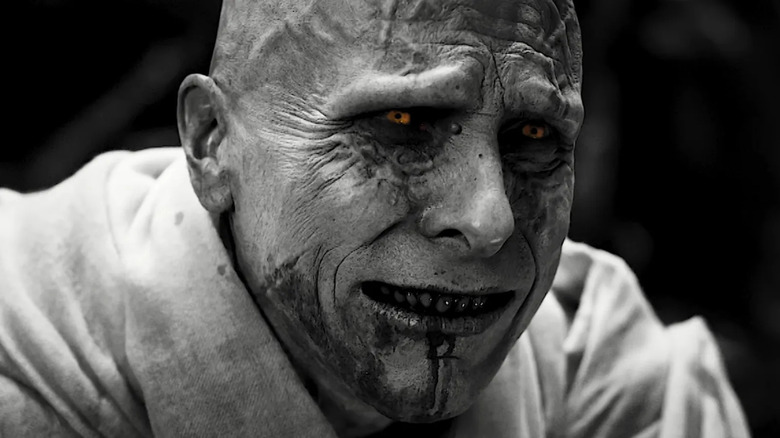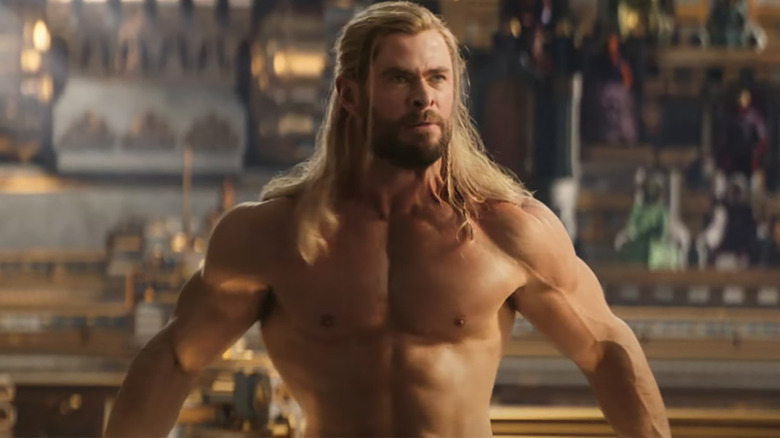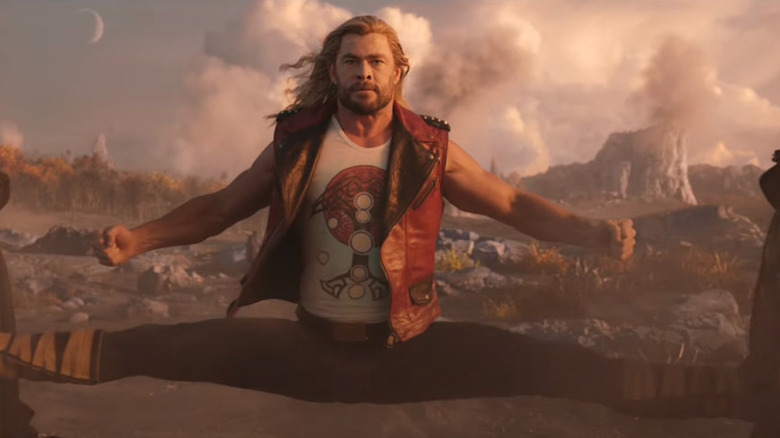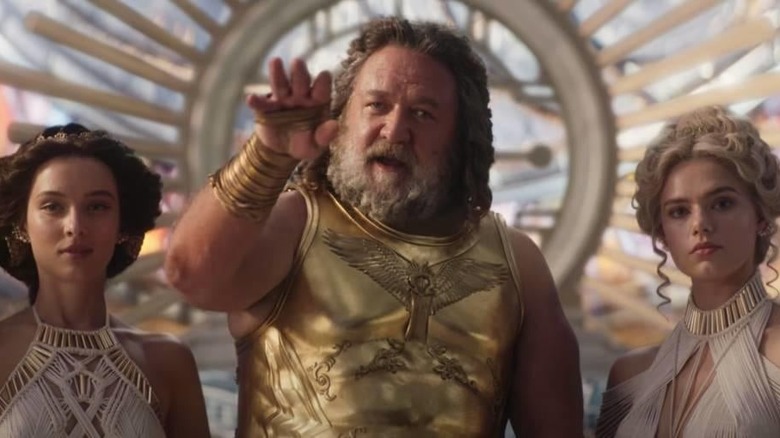The 6 Wildest Moments In Thor: Love And Thunder, Ranked
Warning: This article contains spoilers for the movie "Thor: Love and Thunder"
Taika Waititi's new film "Thor: Love and Thunder" (the 29th film in the MCU) is all about, as the title indicates, the love life of the God of Thunder. Over the course of the character's multiple film appearances, Thor went from a generic "blowhard who needs to be humbled" character to a buffoonish comedy sidekick who just happens to lead his own movies. The code on Thor (Chris Hemsworth) was finally cracked by Waititi in his 2017 film "Thor: Ragnarok," which saw the title character held captive on a garbage-strewn planet and forced to fight in gladiatorial combat against a big, green "friend from work." The tone was light and silly and fun, and with the heavier drama was kept to a low ebb. That lightness continues into "Love and Thunder," a film that features a typical story about a scary supervillain (Christian Bale) wanting to destroy all gods, but the movie focuses more on Thor's awkward reunion with Dr. Jane Foster (Natalie Portman), a character he previously had a romantic falling out with but has now become a superhero in her own right.
Having grown up in the era of Gun N' Roses, sci-fi pinball machines, and Heavy Metal magazine, Waititi attempts to infuse "Love and Thunder" with a lot of wild, '80s-inflected fantasy imagery cribbed from those sources. Several tracks from GNR's seminal 1987 metal album "Appetite for Destruction" appear on the soundtrack (along with their "November Rain," which is from "Use Your Illusion I"), as does an artificial-flavoring color palate, perhaps meant to evoke the high-sucrose snacks Waititi downed by the fistful while playing Data East's "Laser War" in high school.
Many moments from "Thor: Love and Thunder" may be described as "wild," and the following six are among the wildest.
6. The screaming goats
At the outset of "Love and Thunder," Thor is tooling around the galaxy with the Guardians of the Galaxy, the raggedy team of bickersome misfits that the God of Thunder fell in with at the conclusion of 2019's "Avengers: Endgame." He has regained his godlike physique (thanks to a training montage), and seems to have lost a great deal of his worldly awareness; Thor is absent-minded, but upbeat, and often steps into Guardians of the Galaxy battles to deal the deathblow to approaching armies of bad guys. Early in the film, Thor and the Guardians defend a sacred alien temple from hawklike marauders, only to be rewarded Toothgnasher and Toothgrinder, a pair of 10-foot-high goats.
The goats don't seem to be adept at much. Presumably they'll be used as beasts of burden and providers of dairy. Their enormous size, however, makes them particularly cumbersome on the Guardians' small spacecraft, and they cause a great deal of chaos, but they eventually become useful for transportation. One can credit Waititi for not including the obvious poop jokes, however, the goats come with a different inconvenience. They do not bleat in the usual fashion, preferring to scream in very unsettlingly human voices. It's immediately evocative of the screaming bear monster that Portman previously encountered in Alex Garland's "Annihilation."
5. Take a bao
Note: The above image is from the delightful Pixar short "Bao," and not from "Thor: Love and Thunder." But it's relevant.
The villain of "Love and Thunder" is a dissatisfied would-be atheist named Gorr (Bale) whose gods abandoned him. I say "would-be," as in the Marvel universe, gods are all very real, tangible beings. Gorr, struggling with his faith after his god permitted the extinction of his people, has aimed to kill all gods. Because most of the gods have become complacent and take their worshipers for granted, losing faith in them is now something Gorr can do to their faces.
The gods have all retired to the remote Omnipotence City where the major deities from all the galaxy's religions congregate. Zeus (Russell Crowe) is among them, along with many other recognizable faces, and several that couldn't possibly be guessed. For instance, Thor gives a little wave to Bao, the god of bao. This god is a gua bao, a small, hand-sized Chinese dumpling traditionally full of red-cooked pork belly, coriander, mustard and peanuts. Bao, the god of bao, has an animated face and a little squeaky, high-pitched voice. It's a cute god, this Bao. There is a god of Bao. And it's a bao. That makes sense.
4. Child soldiers
Part of Gorr's evil plan involves kidnapping all the children of Thor's native village of Asgard, now on Earth in New Asgard. He keeps them in a walking cage, with echoes of the Baba Yaga folktale, and occasionally appears in the cage in order to frighten them. Gorr can move through shadows and lives in a realm where all color seems to have vanished, save for the orange glow in his eyes. His universe-destroying goal is typical for a superhero film, but his look and behavior is straight out of a nightmare. Gorr is the best thing about "Love and Thunder."
At the film's climax, when Gorr is on the cusp of completing his evil, he has let the children out of their cage and gone wandering toward a magical portal. Both the original Thor and Jane Foster as Mighty Thor enlist the Asgardian children to fight through a thicket of monsters to confront Gorr once and for all. Thor gives a rousing speech, asks that they each find whatever they can pick up in the cluttered vicinity, and blesses their new "weapons" with the power of Thor. The children, swinging rocks and sticks and all sorts of makeshift weapons, lay waste to the shadowbeasts. Most notably, a young girl, wailing in wrath, holds up her stuffed bunny toy, which breaks forth with a blast of mystical energy out of its mouth that cuts through monsters like butter. Killer bunny toy! You gotta love it!
3. Buttocks of thunder
"Thor: Love and Thunder" features a brief moment of nudity. This is wildly shocking for a series that has remained frustratingly chaste for 16 straight years. As Esquire magazine pointed out in 2021, Marvel is weird about sex. It took Chloe Zhaoe's "Eternals" to have a sex scene appear in this particular series, and it presented few other overtly sexual references other than handsome people standing around in tight costumes, sporting tight abs. While these kid-friendly superhero entertainments don't require a high frequency of orgies (something also mentioned in "Love and Thunder), overt displays of human sexuality would be nice from time to time. Let the audience know that these characters have blood pumping through their veins.
So the appearance of Chris Hemsworth's nude buttocks, for however brief they may be visible, is as wild as any Bao god or screaming goat. Hemsworth, as most actors do when appearing in superhero films, clearly built up his muscle mass, no doubt because he anticipated this scene in the buff. Additionally, when a group of Zeus' concubines catches sight of Thor from the front, they proceed to faint dead away. One of the male guards also staggers a bit. They are greatly disappointed when Thor is clothed again. Beefcake scenes are a trademark of the MCU, but it's nice to see someone react with palpable lust to something.
2. The Van Damme splits
Looking back to the opening scenes of "Love and Thunder," and to the battle that won Thor his screaming goats, audiences find that the God of Thunder has expanded his fight repertoire. Previously, Thor was a caped god who swung his mighty hammer with lightning right behind it. By "Love and Thunder," he has a new head on his shoulders, a powerful axe, and quite a lovely set of abs. The axe, nicknamed Stormbreaker, can channel magical powers, fire lightning bolts, and cut through just about anything with a hard enough chop, it seems. Thor, meanwhile, seems to have gotten more comfortable with fist-fighting and actual martial arts moves, as proved in a scene wherein — perhaps inspired by the masterful Jean-Claude Van Damme — Thor can stop two speeding vehicles on either side of him by kicking his legs out in the splits.
If, upon entering the theater, an audience was looking forward to grounded, hefty fights that employed actual gravity, this scene will convince them to leave their preconceptions far behind.
1. God is dead
Perhaps it's no surprise that Gorr does not accomplish his task of killing all the gods. Many of the gods in "Love and Thunder" survive the events of the film, but not all of them make it out okay. Upon visiting Omnipotence City, Thor, Valkyrie (Tessa Thompson), and Dr. Jane Foster confront Zeus about his sloth and his unwillingness to aid other gods that might be in danger. His weapon of choice, as is well known, is his lightning bolt, envisioned as a zig-zagged piece of metal. When he refuses Thor's request to help them stop Goor, Valkyrie leaps to his defense, and Zeus hurls his lightning bolt at her. Being quick, Valkyrie catches it and immediately hurls it back, impaling Zeus right through the chest.
Deicide is a rare sight in films, especially in fluffy, lighthearted teen-friendly entertainment like "Thor: Love and Thunder." Zeus keels over. The death of the gods don't seem to have much of an impact on the outside world, but surely many major churches disbanded in that moment. The last time a god was killed in such a cavalier fashion was when Spock, a being of logic, murdered God with a starship in "Star Trek V: The Final Frontier."
A post-credits stinger reveals that Zeus made it out okay, but for a moment, god was dead.
"Thor: Love and Thunder" is in theaters everywhere now.

